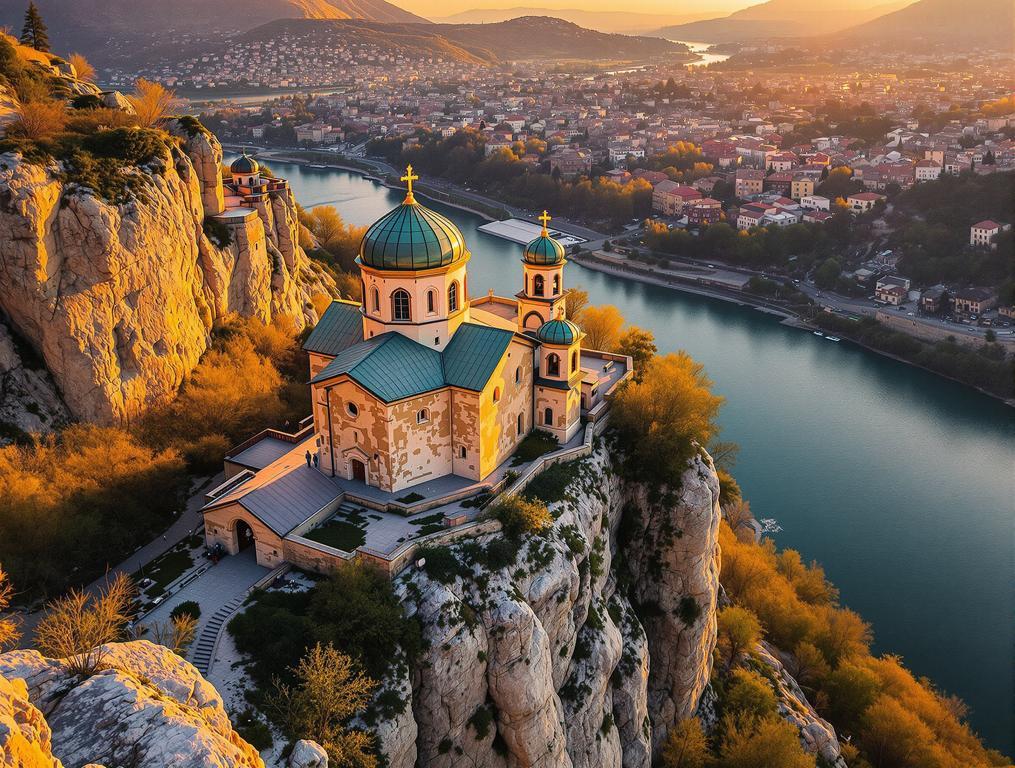I’m standing at the edge of two rivers, where they converge like liquid history beneath the morning light. Just 20 minutes from Tbilisi, Mtskheta rises before me – a tiny Georgian city of 7,392 residents that’s been continuously inhabited since the 5th century BC. What strikes me immediately isn’t just the age, but the density of significance: within 9.6 square kilometers, three UNESCO World Heritage monuments punctuate the landscape, each telling chapters of a story that began before Rome was even founded.
My Georgian friend calls this place “the soul’s first home,” and as I climb the winding path toward Jvari Monastery perched dramatically above the confluence, I understand why. This isn’t just another ancient settlement – it’s where Christianity entered Georgia in 337 AD, forever changing the cultural landscape of the Caucasus.
Georgia’s Hidden Religious Marvel: 3 UNESCO Churches in 9.6 km²
The numbers alone tell a remarkable story. Three major UNESCO monuments are concentrated in this pocket-sized city, creating one of the highest ratios of world-class religious architecture per square kilometer anywhere on earth.
Jvari Monastery stands sentinel on its rocky promontory, a 6th-century masterpiece that pioneered the architectural cross-dome style that would later influence churches throughout eastern Christianity. From its windswept heights, I can see the entire ancient capital below.
At the city’s heart lies Svetitskhoveli Cathedral, an 11th-century marvel believed to house Christ’s mantle. Inside its soaring stone walls, centuries of Georgian kings were crowned and buried. The cathedral’s name translates to “Life-Giving Pillar,” referencing a cedar column said to have miraculous healing properties.
Completing this sacred triangle is Samtavro Monastery, where King Mirian and Queen Nana – Georgia’s first Christian monarchs – are entombed. While France’s forgotten Romanesque treasures often get more international attention, Georgia’s spiritual birthplace holds equal architectural significance with far fewer crowds.
From Endangered to Exemplary: How Mtskheta Preserved Its 1,700-Year Heritage
What’s truly remarkable about Mtskheta is its recent preservation triumph. In 2016, UNESCO removed the city from its endangered list after years of careful restoration. Unlike Bolivia’s white-washed UNESCO capital of Sucre, Mtskheta faced serious endangerment before its remarkable turnaround.
Urban development threatened to overwhelm the delicate historical fabric, and some restoration efforts actually damaged the original structures. Through coordinated conservation, the city reversed course, becoming a model for heritage preservation in the region.
“Every stone here tells two stories – one from the ancient past and another about how we saved it from disappearing. You cannot find this dual narrative in overcrowded European religious sites where tourism has erased authenticity.”
The authenticity is palpable. As I walk the quiet lanes connecting these monuments, local life continues undisturbed. Elderly Georgians tend gardens in the shadow of millennium-old walls. Children play near ancient stone carvings. Less than 10,000 tourists annually visit this architectural treasure trove, compared to millions flooding similar sites in Turkey or Greece.
What the Guidebooks Won’t Tell You
The best approach to Mtskheta comes from Tbilisi’s Didube bus station, where marshrutkas (minibuses) make the 20-minute journey for just 1 GEL (about $0.35). While archaeological museums catalog the area’s history, they miss the living heritage.
Visit at sunrise to experience Jvari Monastery without crowds – unlike Chichen Itza’s equinox spectacle that draws thousands, you might have this architectural marvel completely to yourself in the golden morning light.
The spring months of April through June offer optimal visiting conditions. Unlike West Virginia’s tiny Weston with its haunted asylum, Mtskheta’s spiritual energy feels redemptive rather than dark, especially when cherry blossoms frame the ancient stones.
For an authentic experience, time your visit to coincide with Orthodox services at Svetitskhoveli (usually 7am and 5pm), when polyphonic chants echo through the cathedral – though remain respectfully at the back if you’re not Orthodox.
As the sunset bathes Mtskheta’s stone monuments in amber light, I find myself lingering at the riverbank where the Aragvi meets the Mtkvari. My wife Sarah would capture this moment perfectly – the way the last rays illuminate the cross atop Jvari while the rivers below mirror the darkening sky. This place carries the quiet confidence of somewhere that has witnessed seventeen centuries of history and will endure seventeen more, whether the world discovers its treasures or not.
